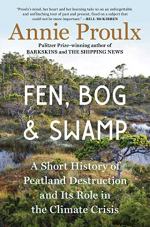|
This section contains 651 words (approx. 2 pages at 400 words per page) |

|
Fen, Bog and Swamp Summary & Study Guide Description
Fen, Bog and Swamp Summary & Study Guide includes comprehensive information and analysis to help you understand the book. This study guide contains the following sections:
This detailed literature summary also contains Topics for Discussion on Fen, Bog and Swamp by Annie Proulx.
The following version of this book was used to create the guide: Proulx, Annie. Fen, Bog and Swamp. Scribner, 2022.
The author was raised in rural Connecticut by a mother who maintained deep relationships with the natural world at large and with wetland ecosystems specifically. This upbringing instilled a lifelong passion for preserving wild spaces that informed the author’s literary career. Despite this upbringing, the author wonders what caused her parents’ generation to destroy the environment while maintaining strong relations with it.
The landscape of the modern world does not resemble the landscape of the pre-industrialized age. Most of the wetland ecosystems have been removed for human purposes, and consequently large amounts of CO2 and methane are released into the atmosphere. Many modern humans do not even know what is missing because they have never developed a relationship with the natural world.
This lack of relationship to nature differentiates Western culture from indigenous cultures worldwide whose worldviews placed humans as only a small part in a web of interlocking relationships. A poverty of relationship to nature has been informed by a loss in language that relating to wild landscapes. Many ethnographers and linguists are currently working to revive this language in hopes that it will connect human beings to their environments.
A lack of relationship to the natural world is also informed by theologies like Christianity and capitalist economic theory. These philosophies act as ontologies that shape the priorities of nearly every country on the globe, and often exclude ecological considerations.
Before the Ice Age when England was still attached to the mainland, it was home to hundreds of thousands of square miles of peatland biomes. This region was home to millennia of human civilizations and houses artifacts that have revolutionized the study of human history. The age of industrialization successfully privatized these regions, a process that led to the draining and cultivation of wetland areas for cropland production. This process is identical to that used to eliminate wetland ecologies all over the world for the last five centuries, and has caused the loss of the remnants of wetland peoples who still preserved ancient cultural practices.
This story was essentially repeated in the Americas, and across the African and Asian continents. With the loss of wetland ecology came a loss in world biodiversity, as thousands of species of birds, insects, plants, mosses, fungi, and microscopic organism died off due to a lack of natural habitat. Additionally, altering wetlands has caused a massive release of CO2 and methane into the atmosphere, further warming a planet on the brink of overheating.
The true value of these ecosystems is not their ability to produce commercial crops like wheat or timber, but their ability to supply ‘refugia,’ or temporary habitat to critically endangered species. Their value also lies in the wealth of literature and art they have inspired, as well as their archeological importance, which has been instrumental in exploring early human history.
Sphagnum moss is a keystone species in all of these ecosystems, and is ecologically critical to the health of the whole biosphere. This is because sphagnum moss has a unique ability to sequester and retain CO2 and methane, a trait that differentiates wetlands from other biotypes.
Attempts to reclaim lost wetlands have had mixed results. In the end, wetlands are slowly created over long periods of time but can be easily destroyed in mere days using advanced technology. The best antidote to environmental decay is to change the perspective of the individual and to direct life towards a slower-paced observational relationship capable of discerning the incremental changes of the natural world. While some conservation projects have been successful, a shift in human mindset is the only force capable of altering the trajectory of climate change. Humans will define their own species by the manner in which they take up the calling to save the last remnants of an intact biosphere.
Read more from the Study Guide
|
This section contains 651 words (approx. 2 pages at 400 words per page) |

|



